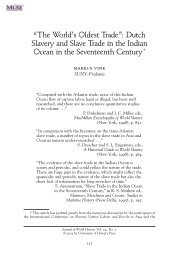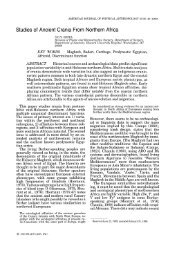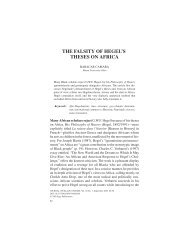GENETICS, EGYPT, AND HISTORY: INTERPRETING ...
GENETICS, EGYPT, AND HISTORY: INTERPRETING ...
GENETICS, EGYPT, AND HISTORY: INTERPRETING ...
Create successful ePaper yourself
Turn your PDF publications into a flip-book with our unique Google optimized e-Paper software.
232 S.O.Y. Keita and A. J. Boyce<br />
The very noteworthy frequency of XII in Tunisia might reasonably in<br />
part be attributed to the settlement of numbers of Roman soldiers and<br />
administrators and their families after the defeat of Carthage, perhaps<br />
increased by some form of sexual or social selection. There was also likely<br />
“Copper-Age” migration from Sardinia (Camps 1982), and ongoing contact<br />
with nearby islands in the Mediterranean. Somewhat surprising for<br />
Tunisia is the relative paucity of VII+VIII given the Phoenician settler<br />
colonies, and its later role in the Islamic period. This is likely due to sampling<br />
since other studies suggest a larger Near Eastern impact (Hammer,<br />
personal communication).<br />
This is a reminder that genes, languages, and nationalities are not<br />
intrinsically linked, and that numerous samples would be helpful in getting<br />
an accurate assessment. The well-known Greek colonies in urban<br />
Cyrenaica (in modern Libya) also must not be forgotten in this regard, as<br />
well as the reflux of European converts to Islam back into Africa, after<br />
the expulsion of Jews and Muslims from Europe in the fifteenth century.<br />
This last event might account for the frequency of haplotype XV in<br />
Morocco.<br />
III<br />
The data for Egypt, north to south, are rendered more interesting in light<br />
of the distributions in adjacent regions. The high prevalence of V in<br />
Ethiopia, south of Egypt, would alone seem to indicate that movements<br />
associated with Dynasty XII and XVIII Egyptian military colonizations<br />
are not sufficient explanations for frequencies in lower Nubia and upper<br />
Egypt, statistically the same. The decreasing cline does not continue.<br />
Ethiopian (and Falasha) frequencies are higher than in upper Egypt. This<br />
observation is not the case for haplotypes VII, VIII, XII, and XV,<br />
although, ironically, haplotype VIII has a notable presence in a sample of<br />
non-Falasha Ethiopians from north of Addis Ababa (Lucotte and Smets<br />
1999).<br />
Leaving aside the smaller frequencies of the “European” haplotypes,<br />
and the likely migrations associated with them (see Lucotte and Mercier<br />
2003a), what other interactions may help explain the patterns of the distributions<br />
of V, XI, IV, VII, and VIII in Africa and southwest Asia (the<br />
Near East)? What were their pre-Middle Kingdom frequencies in the<br />
Egyptian Nile valley, and what events may have helped shape them? We<br />
hypothesize that early holocene settlement and population interactions,<br />
not later military incursions, are the major mechanisms that accounts for<br />
the haplotype patterns, and that prevalence locates their most parsimo-


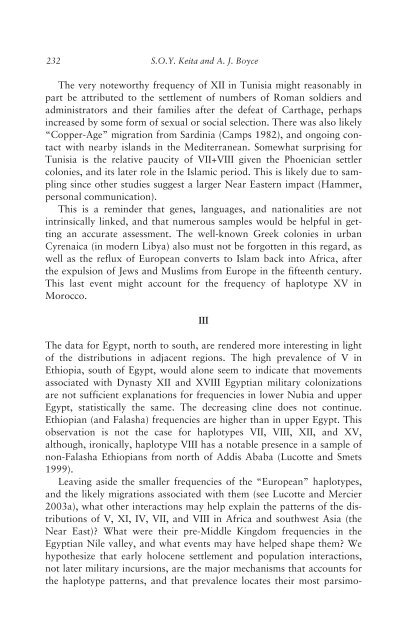

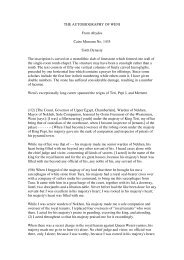
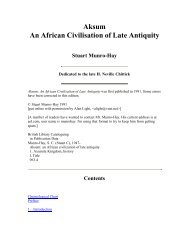

![The Negro trail blazers of California [microform] : a ... - Homestead](https://img.yumpu.com/32436613/1/174x260/the-negro-trail-blazers-of-california-microform-a-homestead.jpg?quality=85)
